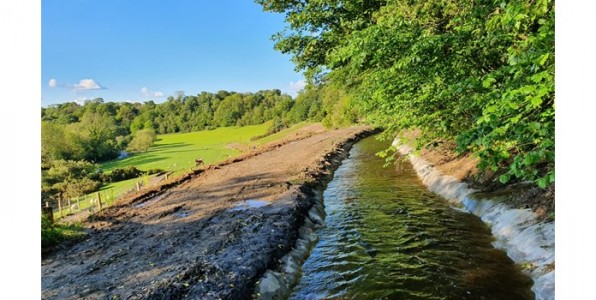Concrete Canvas used as part of improvement works for Scottish Canals

Concrete Canvas used as part of improvement works for Scottish Canals
Concrete Canvas used as part
of improvement works for Scottish Canals

Earlier this year Mackenzie Construction
installed over 2000m2 of Concrete Canvas to provide an erosion
protection layer for an open canal, which is the only formal water supply to
the Union Canal which runs from Falkirk to Edinburgh. The Almond Feeder is just
3km in length and has four masonry tunnels on the route which was opened in
1822.
After the Union Canal was closed in 1965, it
reopened in 2001 and as such the canal feeders are routinely checked to ensure
their structural security. When the Almond Feeder was checked, it was
discovered that there were visual signs of ground movement which raised
concerns over the stability of the channel. In order to protect the channel,
remedial works were deemed essential, as without the Almond Feeder, the Union
Canal would dewater. This would cause significant environmental, public,
economic and navigational issues for the areas it flows through.
A solution to protect the channel long-term was
needed. Initially, the idea of lining the Almond Feeder with HDPE was
considered. However, it quickly became apparent that there were multiple issues
with this idea. The main one being, it was not possible to completely dry out
the channel, as a result thermally welding the material would have been very
difficult.
One solution which was identified as being able
to provide the necessary long-term protection against erosion, while also
improving the impermeability of the channel was Concrete Canvas. Developed by
two students while still at university back in 2004, this material is filled
with a dry concrete mix and needs only to be hydrated and left to dry to form a
fibre reinforced concrete layer. Produced by Concrete Canvas Ltd, the geotextile is available in a number of thicknesses,
and for this project CC8TM, the 8mm thick product variant was used.
When compared to HDPE, Concrete Canvas is more durable and is also resistant to
UV exposure.
The installation of Concrete Canvas
differentiates it from traditional concrete solutions, such as poured or
sprayed, in a number of ways. Firstly, it requires no plant or mixing equipment
on site, which for projects that may have restricted access is hugely
beneficial. Secondly, as the fabric arrives on site rolled and ready to be
installed, it can significantly reduce the overall project time. Only hand
tools are needed to cut the material into the desired length so they can be
installed. Compare this to sprayed concrete, and it is a much more efficient
process with significantly less waste. Furthermore, Concrete Canvas uses a high
early strength concrete mix which allows it to reach performance strength just
24 hours after hydration. Particularly useful in projects where water is
present, Concrete Canvas cannot be over-hydrated and can even set underwater.
For this channel lining project, this was critical as the Union Canal needed to continue
receiving water from the Almond Feeder. Sections of the channel were dewatered,
during which time the CC8 was installed and then hydrated, after which the
water was allowed to run through the section.

The lengths of CC8 were laid transversely across
the channel and the ends fitted into a pre-dug anchor trench to secure them
using 250mm ground pegs. The anchor trench was then backfilled with either clay
or excavated soil. All leading edges of CC8 at the masonry tunnels were
captured in poured concrete to provide extra protection against undermining.
Additional sections of fabric were then installed with 100mm overlaps and
sealed using a bead of Soudaseal Adhesive sealant. These sections were then
screwed together at 200mm internals with stainless steel screws.
It took only four weeks to install the Concrete
Canvas along the whole channel. The work included channel excavation to remove
debris and was completed by just a 5-man crew. 2,125m2 of Concrete
Canvas was used along the 3km channel, and the project finished on schedule.
Mackenzie Construction were able to install over 40 linear metres of the GCCM
per day, demonstrating just how fast Concrete Canvas can be installed.
Comments are closed